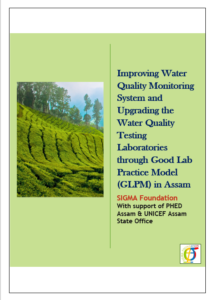Improving Water Quality Monitoring System and Upgrading the Water Quality Testing Laboratories through Good Lab Practice Model (GLPM) in Assam
Contributed By: Dr. M.N. Roy, Dr. Debasri Mukherjee, Er. Sohini Tarafdar, Mr. Rajarshi Banerjee, Mrs. Debaleena Bhattacharya, Mr. Monoj DasThe study was taken up with an objective to meet the challenges being faced for putting in place a sound system of WQMS in Assam. Also, there was urgency to improve functioning of the DLLs of the districts covered under the World Bank funded Neer Nirmal Pariyojana (NNP) and as recommended in the report of SIGMA Foundation based on study conducted in 2017, some of the DLLs were to be upgraded to function as Zonal Referral Laboratory. There was, therefore, need to provide advance training to the lab personnel of six DLLs located in the NNP districts so that those labs could attain NABL (National Accreditation Board for Testing & Calibration Laboratory, 2005) over time. GOA also desired that the DLL at Jorhat should be NABL accredited as soon as possible as the pilot district and lessons learnt would be useful in receiving NABL accreditation by the other labs of the NNP districts. Further, the SRL, Betkuchi was to be strengthened to have NABL accreditation of some more parameters, which are critical.
A Three-Fold Intervention activity was taken up by SIGMA Foundation which included various capacity building measures including training of individual lab professionals and development of institutional capacities of improving quality standards for the six DLLs, and more intensive capacity building of Jorhat DLLs and the SRL. The first intervention was to train the lab personnel of all the DLLs. This was a sort of refresher training on various lab practices, training on new techniques for testing fluoride and bacteriological quality using Rapid Membrane Filtration Technique (RMFT) for quick estimation of bacteriological contamination and training all the participants on the concept and practice of Good Lab Practise Model (GLPM), which is a maiden attempt in drinking water sector in Assam and probably also in the entire country. Training them on sanitary survey was another component as per the MOU. The second part was to orient the lab personnel of the DLLs of 6 NNP districts (later Hilakandi DLL was included for training as a special consideration) districts on various processes and practices to ensure quality of testing and related documentation as the first step of journey towards NABL accreditation. The third component was taking the first step towards NABL accreditation of Jorhat DLL and NABL accreditation for some of the critical parameters like Arsenic, Fluoride, Iron and Nitrate for SRL, Betkuchi. This was assessment of the labs to know the gaps in infrastructures and processes followed in the labs compared to what is required to become accredited with NABL for the relevant parameters and to work out a road map towards their receiving NABL accreditation.
A way forward was provided for strengthening WQMS in Assam, developing a road map for strengthening WQMS, policy issues and state level supports, HR Policy for the lab professionals, taking stock of the lab infrastructure, procurement and O&M of equipment, generating awareness of the lab functionaries and the engineers, strengthening arrangement for capacity building, system of monitoring test reports on water quality, conducting sanitary survey of water sources and uploading results, developing own analytical methods in WQMS lab, system of inspection of labs and supervision, NABL accreditation of the proposed zonal referral labs and possible improvement of the uniform drinking water quality monitoring protocol.

